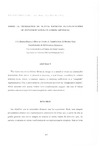Please use this identifier to cite or link to this item:
https://accedacris.ulpgc.es/handle/10553/57058
| DC Field | Value | Language |
|---|---|---|
| dc.contributor.author | Muñoz Blanco, José Antonio | en_US |
| dc.contributor.author | Bolívar Toledo, Olga | en_US |
| dc.contributor.author | Candela Solá, Santiago | en_US |
| dc.contributor.author | Moreno Díaz, Roberto | en_US |
| dc.date.accessioned | 2019-10-11T17:44:50Z | - |
| dc.date.available | 2019-10-11T17:44:50Z | - |
| dc.date.issued | 1991 | en_US |
| dc.identifier.issn | 1130-4723 | en_US |
| dc.identifier.other | Dialnet | |
| dc.identifier.uri | https://accedacris.ulpgc.es/handle/10553/57058 | - |
| dc.description.abstract | The objectives are as follows : given an image, it is aimed to obtain an alternative description, from where to proceed to generate a new image, according to certain selection rules, which, in essence, consists in selecting coefficients in a "complete" representation. This is performed in a hierarchycal structure by "computation layers", which generate new spaces (higher level tranformated images), the last of which permits a decision layer for visual recognition and/or classification. | en_US |
| dc.description.abstract | Los objetivos que se pretenden alcanzar son los siguientes : dada una imagen pretendemos obtener una representación alternativa de forma que, a partir de ella se pueda generar una nueva imagen de acuerdo a ciertas reglas de selección que, en esencia, consisten en extraer coeficientes de una representación completa. Esto se lleva a cabo a través de una estructura jerarquía. mediante "computación por capas", que genera nuevos espacios (imágenes transformadas de mas alto nivel), permitiéndonos la última de ellas tomar una decisión para reconocimiento y / o clasificación visual. | en_US |
| dc.language | spa | en_US |
| dc.relation.ispartof | Revista de la Academia Canaria de Ciencias | en_US |
| dc.source | Revista de la Academia Canaria de Ciencias = Folia Canariensis Academiae Scientiarum [ISSN 1130-4723], v. 3 (2), p. 105-118 | en_US |
| dc.subject | 120304 Inteligencia artificial | en_US |
| dc.subject.other | Artificial vision | en_US |
| dc.subject.other | Visión artificial | en_US |
| dc.title | Sobre la generación de nuevos espacios de coeficientes de representación en visión artificial | en_US |
| dc.type | info:eu-repo/semantics/article | en_US |
| dc.type | Article | en_US |
| dc.identifier.url | http://dialnet.unirioja.es/servlet/articulo?codigo=2905220 | - |
| dc.description.lastpage | 118 | - |
| dc.identifier.issue | 2 | - |
| dc.description.firstpage | 105 | - |
| dc.relation.volume | 3 | - |
| dc.investigacion | Ingeniería y Arquitectura | en_US |
| dc.type2 | Artículo | en_US |
| dc.contributor.authordialnetid | 2421194 | - |
| dc.contributor.authordialnetid | 574958 | - |
| dc.contributor.authordialnetid | 1213701 | - |
| dc.contributor.authordialnetid | 1213705 | - |
| dc.identifier.dialnet | 2905220ARTREV | - |
| dc.identifier.ulpgc | Sí | es |
| item.fulltext | Con texto completo | - |
| item.grantfulltext | open | - |
| crisitem.author.dept | GIR IUCES: Computación inteligente, percepción y big data | - |
| crisitem.author.dept | IU de Cibernética, Empresa y Sociedad (IUCES) | - |
| crisitem.author.dept | Departamento de Informática y Sistemas | - |
| crisitem.author.dept | GIR IUCES: Computación inteligente, percepción y big data | - |
| crisitem.author.dept | IU de Cibernética, Empresa y Sociedad (IUCES) | - |
| crisitem.author.orcid | 0009-0008-9619-7341 | - |
| crisitem.author.parentorg | IU de Cibernética, Empresa y Sociedad (IUCES) | - |
| crisitem.author.parentorg | IU de Cibernética, Empresa y Sociedad (IUCES) | - |
| crisitem.author.fullName | Muñoz Blanco, José Antonio | - |
| crisitem.author.fullName | Moreno Díaz,Roberto | - |
| Appears in Collections: | Artículos | |
Page view(s)
137
checked on May 31, 2025
Download(s)
68
checked on May 31, 2025
Google ScholarTM
Check
Share
Export metadata
Items in accedaCRIS are protected by copyright, with all rights reserved, unless otherwise indicated.
